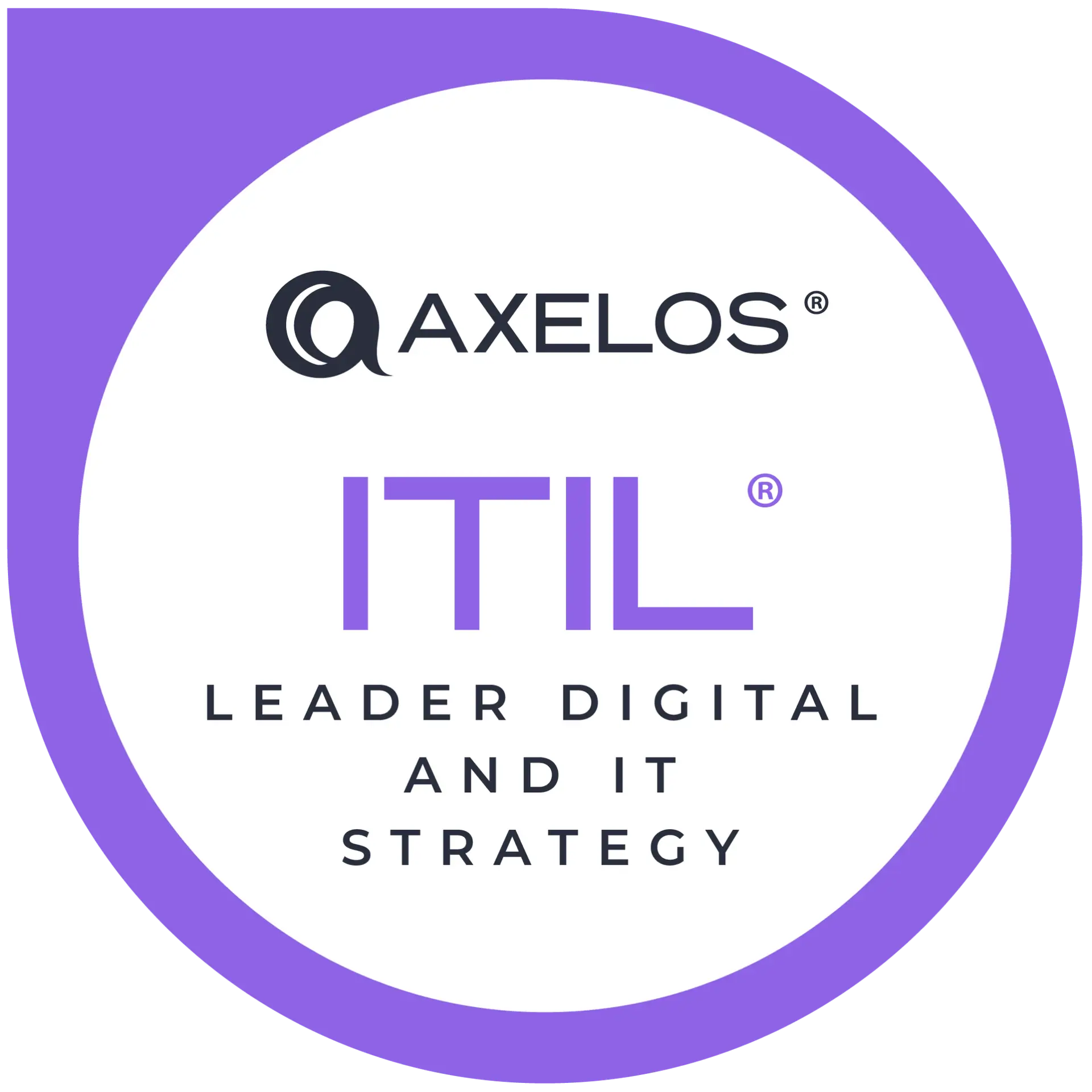ITIL 4 Strategic Leader: Digital and IT Strategy Training

ITIL 4 Strategic Leader: Digital and IT Strategy
The course explores the use of the ITIL framework to support organizations in their digital transformation journey by providing a structured and flexible approach for addressing service management challenges and utilizing the potential of modern technology to get the most value from digital technology. It also adds a new perspective to the ITIL suite and elevates the discussion around ITIL concepts into strategic levels among companies and business leaders.
Training at a glance
Level
Advanced
Duration
3 Days
Experience
3 years: ITIL
Average Salary
$96,560
Labs
No
Level
Advanced
Duration
3 Days
Experience
3 years: ITIL
Average Salary
$96,560
Labs
No
Training Details
The course covers the following ITIL 4 practices to enable students to understand the factors that contribute to success in this arena:
- Architecture Management
- Measurement and Reporting
- Portfolio Management
- Risk Management
- Service Financial Management
- Strategy Management
- Workforce and Talent Management
Module 00: Course Introduction
Module 01: DITS Case Study
- Analysis of the DITS Case Study and Risk Assessment Report
Module 02: DITS Overview
- Background and Introductory Information
Module 03: DITS and the Guiding Principles
- Apply the ITIL Guiding Principles to All Aspects of DITS
Module 04: Key Concepts Applied to Strategy
- Understand ‘Digital’ Concepts – Digital Technology, Digital Business, Digital Organization, Digital Transformation, Digitization
Module 05: Products and Services
- Differentiate Between Product and Service Management, Digital and IT Strategies, Business Strategies and Business Models
Module 06: DITS and the SVS
- Opportunity/Demand; Value
- Governance; Continual Improvement
- Practices
Module 07: Strategy Management (StM) Practice
- Purpose
- Practice Success Factors
Module 08: DITS, SVS SVC Creating Value
- External Analysis: PESTLE
- Internal Analysis: Four Dimensions
Module 09: Digital Disruption and Organizational Viability
- Organizational Viability, Agility, Resilience
Module 10: VUCA (Practical Assignments)
- Explain and Apply VUCA
Module 11: Digital Transformation (Practical Assignments)
- VUCA & Digital Transformation
- Applying HVIT Concepts
Module 12: Digital Disruption and Organizational Viability
- Three Levels of Digital Disruption: Ecosystem, Industry/Market, Organization
Module 13: Influencing an Organizational Position
- Customer/Market Relevance
- Operational Excellence
Module 14: Digital Positioning Tools (Practical Assignments)
- Digital Positioning Tools: Maturity Models, Digital Positioning Models
- Maturity Models
Module 15: Digital Positioning Models (Practical Assignments)
- Digital Positioning Models
- Practical Assignment #1
Module 16: Customer/Market Relevance and Operational Excellence
- Achieve Customer/Market Relevance
- Customer Vs. Market Relevance Definitions
- Customer Journey
Module 17: Omnichannel Delivery and Support
- Omnichannel Delivery
- Context Sensitive Delivery and Support
- Customer Analytics, Customer 360 And Feedback
Module 18: Achieving Operational Excellence
- Relationship Between the Four Dimensions and Operational Excellence
- Competitive Advantage, Continual Improvement, Automation
Module 19: Service Optimization
- Service Optimization
- Technology Replacement Modernization
- Sourcing Strategies
- Workforce Strategies
- Employee 360 Approach
Module 20: Financial Aspects of DITS
- Policies
- Portfolios
Module 21: Funding Projects, Products, Services
- Funding Projects, Products/Services
- Balancing Innovation and Operations
- Charging and Charging Models
Module 22: Service Financial Management (SFM) Practice
- Purpose
- Practice Success Factors
Module 23: Portfolio Management Practice
- Purpose
- Practice Success Factors
Module 24: Strategic Approaches for Digital Organizations (Practical Assignments)
- Barrett Model
- Evolution. Innovation
- Agility & Resilience
- Organizational Change Management, Knowledge Management
Module 25: Social Responsibility & Sustainability (Practical Assignments)
- Social Responsibility, Sustainability
- Triple Bottom Line
- Employee Fulfillment
- Practical Assignment #2
Module 26: Risk and Opportunities
- Risk Management for Digital Organizations
- Risk Definitions, DICE, Risk Posture / Capacity / Appetite / Attitude
- Qualitative and Quantitative Assessment
- Risk Treatment
Module 27: Risk Management (RM) Practice
- Purpose
- Practice Success Factors
Module 28: Encouraging & Managing Innovation
- What Is It
- Innovation Management
Module 29: Technology Adoption Lifecycle
- Technology Adoption Lifecycle
- Developing an Innovation Culture
Module 30: Creating a Digital Strategy
- Digital Readiness Assessment
- Evaluating Current Capabilities
Module 31: Vision and Strategy
- What is a Vision?
- Strategic Planning
Module 32: Using a Business Case for DITS
- Business Case, Portfolio, and Strategy Relationships
- Communicating a Business Case
- Dealing with Resistance
Module 33: Implementing Digital Strategy
- Operating Models
- Organizational Structure
Module 34: Architecture Management (AM) Practice
- Purpose
- Practice Success Factors
Module 35: Workforce & Talent Management (WTM) Practice
- Purpose
- Practice Success Factors
Module 36: Skills for Digital Leaders
- Digital Mindset
- Communication & Relationship Management
- Agile Management
Module 37: Leadership Skills
- Leadership Skills
- Education / Learning / Training
Module 38: Strategy Coordination & Implementation (Practical Assignments)
- Strategy Implementation – General Information
- Satir Model
Module 39: Large-Scale Transformation (Practical Assignments)
- Large-Scale Implementation
- Incremental Implementation
- Mergers/Acquisitions
- Individual Change Implementation
- Practical Assignment #3
Module 40: Parallel Operating Models (POMs)
- Cannibalism, Erosion
- Concurrence
- Synergism
Module 41: Assessing the Success of a DITS
- Metrics
- Cascading/Linking Measurements
Module 42: Objectives & Key Results (OKR)
- Objectives & Key Results (OKRs)
- Measurement Principles: Progress, Performance, Relevance
Module 43: Instrumenting Strategy
- Instrumenting Strategy
- Operational Reports/Dashboards
- Analytical Reports
Module 44: Measurement and Reporting (MR) Practice
- Purpose
- Practice Success Factors
Module 45: Activities of a Digital Transformation Program (Practical Assignments)
- Define Activities by Scope and Objective of the Transformation
Module 46: Course Summary
The Digital and IT Strategy (DITS) Course can be taken if you have:
- Taken and completed the ITIL 4 Foundation Certification
- Taken and completed the ITIL 4 Managing Professional Certification
Please note that if you are ITIL 4 Managing Professional Certified, completing this course, the 4 case studies and successfully passing the PeopleCert DITS Exam will give you DITS Certification and the ITIL 4 Strategic Leader Designation. If you come to this course from the ITIL 4 Foundation Certification, then you will need to take this course and the ITIL 4 Strategic Leader Direct, Plan and Improve Course in addition to this course to achieve the ITIL 4 Strategic Leader Designation.
Some level of work experience in IT service support or IT service delivery is highly recommended.
Upcoming Classes
We Offer More Than Just ITIL Training
Our successful training results keep our corporate and military clients returning. That’s because we provide everything you need to succeed. This is true for all of our courses.
Strategic Planning & Project Management
From Lean Six Sigma to Project Management Institute Project Management Professional, Agile and SCRUM, we offer the best-in-class strategic planning and project management training available. Work closely with our seasoned multi-decade project managers.
IT & Cybersecurity
ATA is the leading OffSec and Hack the Box US training provider, and a CompTIA and EC-Council award-winning training partner. We offer the best offensive and defensive cyber training to keep your team ahead of the technology skills curve.
Leadership & Management
Let us teach your team the high-level traits and micro-level tools & strategies of effective 21st-century leadership. Empower your team to play to each others’ strengths, inspire others and build a culture that values communication, authenticity, and community.
